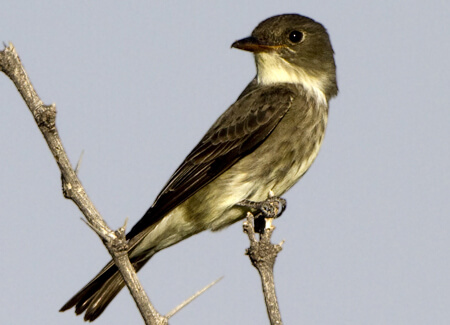 The Olive-sided Flycatcher has a distinctive song: a sharply whistled, “Quick, three BEERS!” With its dark back and streaked sides that contrast with a white throat, chest and belly, the bird looks as though it's wearing a vest.
The Olive-sided Flycatcher has a distinctive song: a sharply whistled, “Quick, three BEERS!” With its dark back and streaked sides that contrast with a white throat, chest and belly, the bird looks as though it's wearing a vest.
These flycatchers feed mostly on flying insects, especially bees, wasps, and ants. They capture prey in typical flycatcher fashion, waiting quietly on an exposed perch, then dashing out to snatch insects from the air. They are the only North American flycatcher to use this hunting method exclusively.
Since the Olive-sided Flycatcher prefers openings and edges, it responds favorably to some logging and fires if sufficient snags and residual trees are left to provide nesting and foraging habitat and singing perches.
Declining Numbers
More than half of the Olive-sided Flycatcher's global population breeds in the boreal forests of North America. They begin to nest relatively late in the breeding season and raise only one brood per year, which contributes to low annual productivity–one of the lowest of any North American songbird.
Sign up for ABC's eNews to learn how you can help protect birds
Overall, the population of Olive-sided Flycatchers has declined by 67 percent since 1966, placing the species on the 2014 Watch List. Extensive habitat loss–on tropical wintering grounds as well as northern breeding grounds, particularly of boreal forest–is a suspected cause. There are also concerns about insect prey availability and climate change.
From Alaska to the Andes

Olive-sided Flycatcher by Martha Marks, Shutterstock
Recent results from birds fitted with geolocators on their breeding grounds in central Alaska showed that they wintered in the northern Andes, centered around Colombia.
ABC and its partners protect many wintering areas for the Olive-sided Flycatcher in these areas, including El Dorado and the Cerulean Warbler Conservation Corridor, in Colombia; Abra Patricia in Peru; and Tapichalaca, Buenaventura, Jorupe, and Rio Canande in Ecuador.
These reserves protect many other migratory songbirds, such as the Cerulean Warbler and Wood Thrush, as well as critically endangered resident species such as the Marvelous Spatuletail and Jocotoco Antpitta.
Many of these reserves have visitor accommodations. Visit Conservation Birding to make your travel plans!
Donate now to support ABC's conservation mission!
Donate to support ABC's conservation mission!



















































